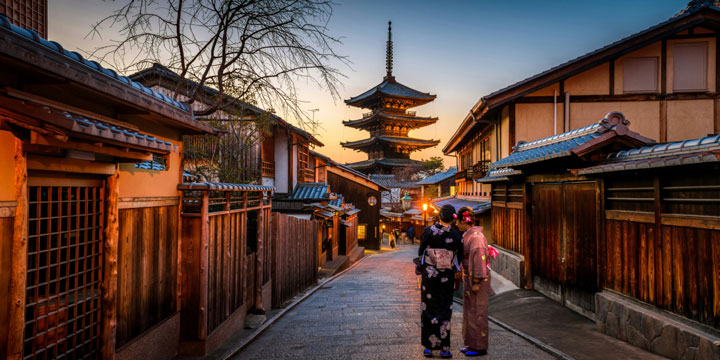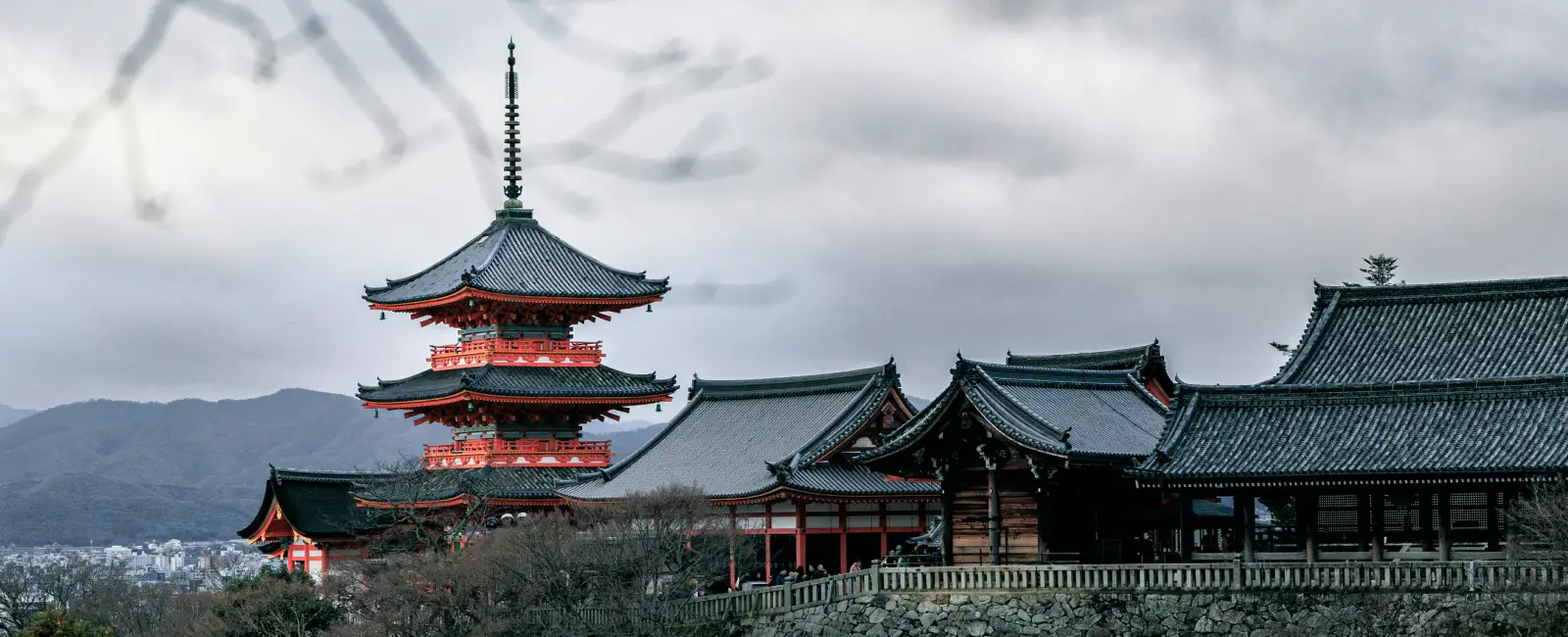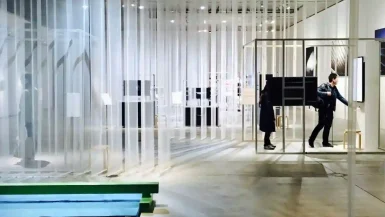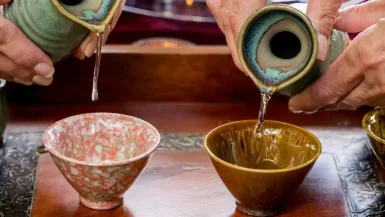Kyoto, the ancient capital of Japan, is a city where history and modernity coexist harmoniously. To truly discover Kyoto, you’ll find it nestled in the Kansai region, offering a mesmerizing blend of traditional temples, serene gardens, and vibrant culture. This makes it a must-visit destination for travelers seeking an authentic Japanese experience. Kyoto’s streets are lined with historic wooden machiya houses, which provide a glimpse into Japan’s architectural past. As you explore, the city’s famous cherry blossoms and autumn foliage create stunning, postcard-worthy scenes that attract visitors from around the world. Kyoto is also home to over 1,600 temples and shrines, each with its own unique story and significance. In addition, the city’s culinary scene is equally captivating, offering everything from traditional kaiseki meals to bustling food markets.
Whether exploring the tranquil Arashiyama Bamboo Grove or walking through the vibrant Gion district, Kyoto seamlessly weaves together its rich history with the energy of modern life.
A Glimpse into Kyoto’s Rich History
Kyoto served as Japan’s capital for over a millennium, from 794 to 1868. During this time, it became the epicenter of Japanese culture, religion, and politics. When you discover Kyoto, its historical significance is palpable as you explore the city. With its well-preserved temples, shrines, and historic districts, the city offers a window into Japan’s illustrious past. Walking through these areas, you’ll gain a deep appreciation for the cultural and historical legacy that Kyoto continues to preserve and showcase.
Temples and Shrines: The Spiritual Heart of Kyoto
Kyoto is home to over 1,600 Buddhist temples and 400 Shinto shrines, each with its own unique charm and historical importance.
Kinkaku-ji (Golden Pavilion):
Perhaps the most iconic of Kyoto’s landmarks, Kinkaku-ji is a stunning Zen Buddhist temple covered in gold leaf, reflecting beautifully in the surrounding pond. When you discover Kyoto, this shimmering temple should be at the top of your list. As you approach the temple, its shimmering exterior captures the sunlight, creating a dazzling display of gold against the serene backdrop. The temple’s lush gardens and meticulously maintained grounds enhance its tranquil atmosphere, inviting visitors to relax and soak in the beauty. Additionally, Kinkaku-ji’s elegant design, with its three-story structure, showcases traditional Japanese architectural styles and intricate craftsmanship. Visitors can stroll along the paths that wind around the pond, offering various vantage points to admire the temple’s reflection and the surrounding nature. During different seasons, the temple provides unique experiences, from cherry blossoms in spring to vibrant autumn foliage.
For those interested in cultural history, Kinkaku-ji has a rich past, originally built in the late 14th century and rebuilt after a fire in 1955. Ultimately, Kinkaku-ji remains a must-see destination, representing the beauty and serenity of Kyoto’s cultural heritage.
Fushimi Inari Taisha
Famous for its thousands of vermillion torii gates that create a winding path up the sacred Mount Inari, this Shinto shrine is a breathtaking sight and offers a unique hiking experience. As you walk through the gates, you’ll be enveloped in a tunnel of vibrant color, enhancing the sense of spiritual journey. The hike up the mountain varies in length, with several trails offering different levels of difficulty and scenery. Along the way, you’ll pass smaller shrines and altars, each with its own distinct charm and significance. The torii gates are donated by individuals and businesses, and each gate bears an inscription of the donor’s name and the date of the donation. The higher you ascend, the fewer people you’ll encounter, allowing for a more tranquil and contemplative experience.
At the summit, you’ll be rewarded with panoramic views of Kyoto and the surrounding countryside, adding to the hike’s allure. Ultimately, the combination of cultural significance, stunning views, and serene atmosphere makes visiting this shrine an unforgettable experience.
Kiyomizu-dera
Famous for its thousands of vermillion torii gates that create a winding path up the sacred Mount Inari, this Shinto shrine is a breathtaking sight and offers a unique hiking experience. As you walk through the gates, you’ll be enveloped in a tunnel of vibrant color, enhancing the sense of spiritual journey. The hike up the mountain varies in length, with several trails offering different levels of difficulty and scenery. Along the way, you’ll pass smaller shrines and altars, each with its own distinct charm and significance. The torii gates are donated by individuals and businesses, and each gate bears an inscription of the donor’s name and the date of the donation.
Moreover, the higher you ascend, the fewer people you’ll encounter, allowing for a more tranquil and contemplative experience. At the summit, you’ll be rewarded with panoramic views of Kyoto and the surrounding countryside, adding to the hike’s allure. Ultimately, the combination of cultural significance, stunning views, and serene atmosphere makes visiting this shrine an unforgettable experience.
Ryoan-ji
Known for its enigmatic rock garden, Ryoan-ji invites contemplation and is a quintessential example of Zen landscape design. As you observe the garden, you’ll notice the meticulously arranged rocks and gravel, designed to evoke a sense of tranquility and introspection. The minimalist layout encourages visitors to reflect on the simplicity and complexity of the natural world. Furthermore, the carefully raked gravel symbolizes water, complementing the sparse arrangement of rocks that represent islands or mountains. Additionally, the surrounding moss-covered stones and carefully pruned trees enhance the garden’s serene atmosphere. Visitors often find that the garden’s design promotes a meditative experience, offering a break from the bustling pace of everyday life.
The temple grounds also feature a beautiful pond and traditional architecture, which add to the overall aesthetic and spiritual experience. Ultimately, Ryoan-ji’s rock garden remains an iconic representation of Zen philosophy, inviting each visitor to find their own meaning in its subtle beauty.
Traditional Districts: A Walk Through Time
Kyoto’s historic districts preserve the ambiance of old Japan, with narrow streets, traditional wooden machiya houses, and tea houses.
Gion
The most famous geisha district in Japan, Gion is a place where tradition comes alive. As you stroll through Hanami-koji Street, you’ll encounter charming wooden machiya houses and tea houses that have preserved their historical charm. Additionally, the area is known for its beautiful traditional architecture, offering a glimpse into Kyoto’s past. Visiting Yasaka Shrine, a historic Shinto shrine located at the edge of Gion, provides a serene atmosphere and a chance to participate in local rituals. Moreover, the shrine’s vibrant festivals, such as the Gion Matsuri, showcase traditional Japanese culture and attract visitors from around the world.
If you’re interested in the performing arts, catching a show at Gion Corner is a must; this venue offers a variety of traditional performances, including tea ceremonies, ikebana, and Kyoto-style dance. Furthermore, Gion’s narrow alleyways and hidden courtyards are perfect for exploration, revealing delightful surprises at every turn. Finally, spending an evening in Gion provides a unique opportunity to experience the elegance of geisha culture and the rich heritage of Kyoto.
Arashiyama
This scenic area is famous for its bamboo groves, the iconic Togetsukyo Bridge, and the Iwatayama Monkey Park. As you discover Kyoto, strolling through the bamboo groves reveals towering stalks that create a calming and immersive environment, almost magical in its tranquility. The Togetsukyo Bridge, with its picturesque setting over the Hozu River, provides stunning views and a perfect photo opportunity. Additionally, the Iwatayama Monkey Park offers a unique experience where you can observe wild macaques in their natural habitat. The park’s trails lead you up the mountain, offering panoramic views of the surrounding landscape and a closer look at the monkeys’ playful behavior. Furthermore, Arashiyama’s traditional streets are lined with charming shops and tea houses, where you can sample local delicacies and shop for souvenirs. By exploring this area, you’ll fully appreciate the blend of natural beauty and cultural charm that defines Kyoto.
For a more tranquil experience, consider visiting the Tenryu-ji Temple, a UNESCO World Heritage site with beautifully landscaped gardens. Overall, Arashiyama’s blend of natural beauty and cultural attractions makes it a perfect escape from the hustle and bustle of the city center.

Gardens and Nature: Tranquility Amidst Urban Life
Kyoto’s gardens are masterpieces of Japanese landscape design, offering tranquility and natural beauty.
Kokedera (Moss Temple)
Known for its lush moss garden, this temple requires a reservation to visit, ensuring a peaceful experience. If you want to discover Kyoto’s serene side, upon arrival, you’ll be greeted by a tranquil atmosphere that invites quiet reflection and appreciation of nature. The meticulously maintained garden features various types of moss, creating a vibrant, green tapestry that changes with the seasons. Visitors often marvel at the intricate patterns and textures, which reflect the temple’s commitment to preserving its natural beauty. In addition to the garden, the temple grounds include traditional architecture that complements the serene setting.
Guided tours may also be available, offering insights into the historical and cultural significance of the temple. To enhance your visit, consider arriving early to avoid crowds and fully immerse yourself in the tranquility. Overall, the reservation system helps maintain the temple’s peaceful environment, making it a truly special destination for those seeking a quiet retreat.
Tenryu-ji
A Zen temple in Arashiyama, Tenryu-ji boasts a beautiful garden that changes with the seasons, from cherry blossoms in spring to vibrant foliage in autumn. In addition to its seasonal displays, the temple’s garden features tranquil koi ponds and meticulously arranged rock gardens. As you stroll through the grounds, you’ll encounter picturesque views that reflect the changing colors and moods of each season. The garden’s design emphasizes harmony and balance, embodying the principles of Zen philosophy. Furthermore, Tenryu-ji’s garden integrates seamlessly with the surrounding natural landscape, enhancing its serene atmosphere. During your visit, you might also observe traditional Japanese tea ceremonies held in the garden, adding to the cultural experience. Moreover, the temple itself, a UNESCO World Heritage site, offers historical and architectural insights that complement the beauty of its garden. Overall, Tenryu-ji provides a captivating blend of natural beauty and cultural heritage, making it a must-visit destination in Arashiyama.
Philosopher’s Path
A scenic walking route along a canal lined with cherry trees, the Philosopher’s Path is especially stunning during sakura season. As you stroll along the path, the delicate pink blossoms create a picturesque canopy overhead, transforming the walkway into a dreamy tunnel of flowers. The gentle sound of flowing water adds to the serene atmosphere, making it a perfect spot for reflection and relaxation. During sakura season, the path becomes a popular destination for both locals and tourists. Many people come to enjoy the breathtaking views and take memorable photographs. Beyond the cherry blossoms, you’ll find charming traditional teahouses and small shops dotted along the route. During autumn, the vibrant fall foliage creates a stunning contrast to the tranquil canal. For a truly immersive experience, consider visiting early in the morning to enjoy the path’s beauty before the crowds arrive.
Read about the significance of Sakura in Japanese culture.
Cultural Experiences: Immerse Yourself in Kyoto’s Traditions
Kyoto offers numerous opportunities to engage with Japanese culture and traditions.
Tea Ceremonies
Participate in a traditional tea ceremony to appreciate the art of matcha and the philosophy behind this age-old practice. As you discover Kyoto, you can immerse yourself in this cultural experience, exploring the city’s rich tea heritage. During the ceremony, you will observe the meticulous preparation of matcha, where every movement and gesture has a purpose and meaning. The ritual begins with the careful whisking of matcha powder into hot water, creating a frothy, vibrant green tea. In Kyoto, as you sit quietly, you’ll experience the serene atmosphere that emphasizes mindfulness and respect. The host will often explain the significance of each step, offering insights into the ceremonial aspects of tea preparation. Furthermore, you’ll have the opportunity to savor the rich, umami flavor of matcha. Ultimately, participating in a traditional tea ceremony in Kyoto provides a unique and enriching experience that celebrates Japan’s cultural heritage.
Kimono Rental
Dress in a kimono and explore the city to feel like you’ve stepped back in time. If you decide to discover Kyoto, the traditional attire will enhance your immersion in the rich cultural heritage of the area. As you wander through historic neighborhoods, many shops in Gion and other districts offer rentals, making it easy to find a relevant kimono. In addition to the rental shops, some places provide complete packages, including hair styling and accessories, to complete your look. Wearing a kimono also allows you to fully appreciate traditional Japanese architecture and gardens, as the attire complements the surroundings beautifully. While exploring, you might also encounter local festivals or events where wearing a kimono is particularly fitting and enjoyable. Furthermore, taking photos in your kimono against the backdrop of historic temples and tea houses makes for unforgettable memories.
Culinary Delights
Kyoto is renowned for its cuisine, from kaiseki (multi-course meals) to street food. As you discover Kyoto, the city’s culinary offerings showcase a blend of traditional flavors and modern innovation. Don’t miss trying yudofu (tofu hot pot), a dish that highlights Kyoto’s emphasis on fresh, local ingredients and subtle, refined flavors. Additionally, Kyoto-style sushi presents a unique take on sushi, often featuring ingredients that reflect the region’s seasonal produce. Moreover, you’ll find yuba (tofu skin) and matcha-flavored treats, which reflect the city’s rich cultural heritage.
For a truly immersive experience as you discover Kyoto, visit one of Kyoto’s traditional markets, where you can sample a variety of local delicacies and interact with friendly vendors. Furthermore, Kyoto’s tea houses offer an opportunity to experience the art of tea preparation, providing a deeper appreciation of Japanese tea culture. Ultimately, Kyoto’s diverse and vibrant food scene ensures that every meal can become a memorable culinary adventure.
Festivals: Celebrating Kyoto’s Heritage
Kyoto’s festivals are vibrant expressions of its rich cultural heritage.
- Gion Matsuri: Held in July, this is Kyoto’s most famous festival, featuring grand processions of floats, traditional music, and dance. The festival is famous as Gion Matsuri. To truly discover Kyoto, you must experience this vibrant event, which attracts visitors from around the world who come to witness its colorful celebrations. Additionally, the festival offers a glimpse into Kyoto’s rich cultural heritage and traditions, making it a must-see experience for anyone visiting the city. Throughout the event, you can enjoy street food, traditional crafts, and the lively atmosphere that fills the historic streets of Kyoto. Whether you’re exploring the city for the first time or returning to deepen your connection with Kyoto, Gion Matsuri provides an unforgettable way to discover the essence of this historic place.
- Aoi Matsuri: One of Kyoto’s three major festivals, Aoi Matsuri in May includes a graceful procession in Heian-period costumes. During the festival, participants don elaborate, traditional attire, recreating the elegance of ancient Japan. The procession travels from the Kamo Shrines to the Shimogamo Shrine, showcasing historical rituals and cultural traditions. Spectators can enjoy a vibrant display of Kyoto’s rich heritage and the festival’s deep historical roots.
- Jidai Matsuri: Celebrating Kyoto’s history, Jidai Matsuri in October showcases historical costumes and reenactments from various periods. The festival features elaborate processions where participants dress in authentic attire from different eras, providing a vivid glimpse into Japan’s rich past. Additionally, traditional music and performances enhance the festival’s immersive experience, making it a captivating event for visitors of all ages. The festival not only honors Kyoto’s historical heritage but also offers an engaging way to experience Japanese culture.
Practical Tips for Travelers
Getting Around: Kyoto’s public transportation system is efficient, with buses and trains covering major attractions. Renting a bicycle is also a great way to explore the city at your own pace.
- Best Time to Visit: Spring (March to May) and autumn (September to November) are ideal for visiting Kyoto, with pleasant weather and beautiful natural scenery. During these seasons, you can truly discover Kyoto’s charm, as cherry blossoms transform the city into a breathtaking landscape of pink and white hues in spring. Similarly, autumn showcases vibrant colors of the maple leaves, creating stunning vistas that enhance Kyoto’s historic temples and gardens. These seasons offer a picturesque backdrop for exploring the city’s rich cultural heritage and outdoor attractions.
- Accommodation: From luxury ryokan (traditional inns) to budget-friendly hostels, Kyoto offers a range of accommodation options to suit every traveler. For those seeking an authentic experience, staying in a ryokan provides a glimpse into traditional Japanese hospitality and culture. Budget travelers can find comfortable and affordable options in hostels that offer convenient amenities and a vibrant atmosphere. Many accommodations in Kyoto are close to major attractions. It’s easy to explore the city’s rich history and vibrant culture.
- Language:While English is not widely spoken, many tourist spots have English signage. Learning a few basic Japanese phrases can enhance your experience. Additionally, having a translation app on your phone can be very helpful in bridging any language gaps. Moreover, local residents often appreciate it when visitors make an effort to speak Japanese, even if it’s just a few words. Overall, small efforts to communicate in Japanese can lead to more positive interactions and a richer travel experience.
Conclusion
Kyoto is a city that captivates the hearts of travelers with its timeless beauty, cultural richness, and serene ambiance. When you discover Kyoto, whether you’re exploring ancient temples, strolling through historic districts, or immersing yourself in traditional experiences, the city promises an unforgettable journey into the soul of Japan. Make sure to add this enchanting destination to your travel bucket list!



